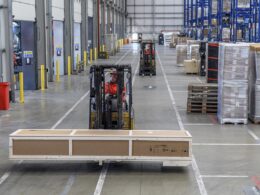Applying the 80/20 rule to electronic data exchange is all very well, but why not aim higher?
Electronic data interchange (EDI) is the digital backbone of all supply chain endeavours. It provides a communicative channel between logistics providers and their customers, allowing for rapid communication and up-to-date information exchange on shipment status and delivery estimates, for example, as well as sales data and customs notices. Good EDI makes for a smooth supply chain, and a happy, well-informed customer base.
Unfortunately, many logistics companies currently have to deal with a whole host of customer EDI systems – different companies have different levels of technical ability and digitisation, meaning that one provider can be forced to integrate with multiple on-premise solutions in order to build their portfolio of customers. That’s an unsustainable model, as many smaller companies may not bring in enough revenue to justify the effort of integrating with their EDI system.
The 80/20 rule
One way of addressing this issue is the 80/20 rule. Time management experts use the 80/20 rule to help businesses run more efficiently. This idea dates back to 1896, when Italian economist Vilfredo Pareto noted that around 80 per cent of the land in Italy was owned by 20 per cent of the population. He also realised that 20 per cent of the peapods in his garden contained 80 per cent of the peas. This observation, which would come to be known as the Pareto Principle, has been proved true in many aspects of life, but it has especially taken off in business, as time-management is integral for success in the industry.
Essentially, it states that in many businesses, 20 per cent of customers bring in 80 percent of the profits; in a supermarket, for example, 20 per cent of suppliers may produce 80 per cent of products. Therefore, when companies are setting up electronic data interchange (EDI), it makes more sense and is more efficient to focus on the 20 per cent of customers that bring in the most profit and work with their systems.
The businesses that produce the greatest profit will likely already have EDI systems, or the means to set them up, and many of these companies are happy to allow the EDI systems to run in the background to manage everything. Up to now, the dictum has been that you should focus on these customers as they are easier to do business with.
Moving to the cloud
The other 80 per cent, however, also need to be managed, despite bringing in only 20 per cent of the profits – that’s still a hefty chunk of revenue. But how do you balance the cost of integrating your EDI with multiple small businesses?
These companies need EDI systems too, but many are restricted by the obstacle of the cost of installing EDI and training their staff to use new programmes. In response to this issue, logistics companies need to implement cloud-based, web-hosted EDI hubs, which make connectivity much easier for SME customers – all they need to integrate with cloud-based systems is a laptop and an internet connection.
Ideally, a cloud-based EDI solution should be able to contact a list of suppliers, or the small firms that make up the other 80 per cent of business, and the company operating it should be able to offer the support and training needed to help introduce the EDI technology that is best for customers. This removes the burden of manually handling excessive data, as the EDI runs in the background, communicating with each business, large or small, freeing up man-hours in other areas of business. The ultimate aim is to reduce human inputting errors and lessen disputes over deliveries or orders by providing full visibility of the entire supply chain for all suppliers.
With integrated cloud-based EDI systems, businesses can optimise their performance through efficient time-management and get all businesses on board through the simple and inexpensive application of the EDI solution. With the right system in place, you don’t need the 80/20 rule – you can go for the whole 100 per cent.
Sian Hopwood, SVP B2B, BluJay Solutions













